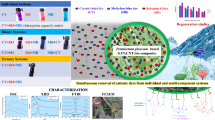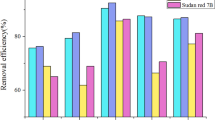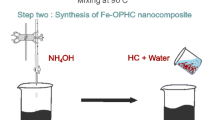Abstract
In this study, jackfruit peel (JP) was blended into sugarcane bagasse (SB) powder during co-hydrothermal carbonization (Co-HTC) to improve the physicochemical properties of JP/SB@4:1 hydrochar for the removal of methylene blue (MB), malachite green (MG), and crystal violet (CV) dyes from aqueous solutions. JP/SB@4:1 was systematically characterized. Spectroscopic, morphological, and elemental analyses confirmed successful binding of MB, CV, and MG dyes with JP/SB@4:1 surface. Influence of various parameters such as contact time, pH, initial dyes concentration, and temperature on the adsorption process was studied. The optimized magnitudes for these parameters were found to be 480 min of contact time; pH 6.6 for MB, 7.6 for MG, and 8.3 for CV; and 328K of temperature. Non-linear kinetic and isotherm models were applied to the experimental data. Results revealed the fitting of pseudo-second-order (PSO) and Langmuir isotherm (LIM) models to experimental data, while the maximum monolayer adsorption capacities (qm) of JP/SB@4:1 toward MB, CV, and MG were 326.79, 300.87, and 922.29 mg/g, respectively. The adsorption of dyes on JP/SB@4:1 was ascribed to electrostatic interaction, hydrogen bonding, and π-π/n-π interactions. Thermodynamics evaluation showed the feasible, spontaneous, and endothermic adsorption of the dyes.




Similar content being viewed by others
Data availability
All data generated or analyzed during this study are included in this manuscript.
References
Ahmad AA, Ahmad MA, Yahaya NKEM, Karim J (2021) Adsorption of malachite green by activated carbon derived from gasified Hevea brasiliensis root. Arabian J Chem 14:103104. https://doi.org/10.1016/j.arabjc.2021.103104
Ma ZW, Zhang KN, Zou ZJ, Lü QF (2021) High specific area activated carbon derived from chitosan hydrogel coated tea saponin: one-step preparation and efficient removal of methylene blue. J Environ Chem Eng 9:105251. https://doi.org/10.1016/j.jece.2021.105251
Tan G, Li X, Xiao D (2020) Adsorption of methylene blue onto porous carbon materials prepared from Na2EDTA. New J Chem 44:4071–4080. https://doi.org/10.1039/C9NJ06154A
Chen D, Zhang H, Yang K, Wang H (2016) Functionalization of 4-aminothiophenol and 3-aminopropyltriethoxysilane with graphene oxide for potential dye and copper removal. J Hazard Mater 310:179–187. https://doi.org/10.1016/j.jhazmat.2016.02.040
Minghua Z, Xiumin F, Rovetta A, Qichang H, Vicentini F, Bingkai L, Giusti A, Yi L (2009) Municipal solid waste management in Pudong New Area, China. Waste Manag 29:1227–1233. https://doi.org/10.1016/j.wasman.2008.07.016
Nguyen MV, Lee BK (2015) Removal of dimethyl sulfide from aqueous solution using cost-effective modified chicken manure biochar produced from slow pyrolysis. Sustain 7:15057–15072. https://doi.org/10.3390/su71115057
Sharma HB, Sarmah AK, Dubey B (2020) Hydrothermal carbonization of renewable waste biomass for solid biofuel production: a discussion on process mechanism, the influence of process parameters, environmental performance and fuel properties of hydrochar. Renew Sustain Energy Rev 123:109761. https://doi.org/10.1016/j.rser.2020.109761
Gupta D, Mahajani SM, Garg A (2020) Investigation on hydrochar and macromolecules recovery opportunities from food waste after hydrothermal carbonization. Sci Total Environ 749:142294. https://doi.org/10.1016/j.scitotenv.2020.142294
Kang S, Li X, Fan J, Chang J (2012) Characterization of hydrochars produced by hydrothermal carbonization of lignin, cellulose, D-xylose, and wood meal. Ind Eng Chem Res 51:9023–9031
Elsayed I, Madduri S, El-Giar EM, Hassan EB (2022) Effective removal of anionic dyes from aqueous solutions by novel polyethylenimine-ozone oxidized hydrochar (PEI-OzHC) adsorbent. Arabian J Chem 15:103757. https://doi.org/10.1016/j.arabjc.2022.103757
Tran TH, Le AH, Pham TH, Nguyen DT, Chang SW, Chung WJ, Nguyen DD (2020) Adsorption isotherms and kinetic modeling of methylene blue dye onto a carbonaceous hydrochar adsorbent derived from coffee husk waste. Sci Total Environ 725:138325. https://doi.org/10.1016/j.scitotenv.2020.138325
Li Y, Meas A, Shan S, Yang R, Gai X (2016) Production and optimization of bamboo hydrochars for adsorption of Congo red and 2-naphthol. Biores Technol 207:379–386. https://doi.org/10.1016/j.biortech.2016.02.012
Islam MT, Chambers C, Toufiq Reza M (2022) Effects of process liquid recirculation on material properties of hydrochar and corresponding adsorption of cationic dye. J Anal Appl Pyrol 161:105418. https://doi.org/10.1016/j.jaap.2021.105418
Haris M, Khan MW, Paz-Ferreiro J, Mahmood N, Eshtiaghi N (2022) Synthesis of functional hydrochar from olive waste for simultaneous removal of azo and non-azo dyes from water. Chem Eng J Adv 9:100233. https://doi.org/10.1016/j.ceja.2021.100233
Tu W, Liu Y, Xie Z, Chen M, Ma L, Du G, Zhu M (2021) A novel activation-hydrochar via hydrothermal carbonization and KOH activation of sewage sludge and coconut shell for biomass wastes: preparation, characterization and adsorption properties. J Colloid Interf Sci 593:390–407. https://doi.org/10.1016/j.jcis.2021.02.133
Li B, Guo J, Lv K, Fan J (2019) Adsorption of methylene blue and Cd(II) onto maleylated modified hydrochar from water. Environ Poll 254:113014. https://doi.org/10.1016/j.envpol.2019.113014
Foo KY, Hameed BH (2012) Potential of jackfruit peel as precursor for activated carbon prepared by microwave induced NaOH activation. Biores Technol 112:143–150. https://doi.org/10.1016/j.biortech.2012.01.178
Sundarraj AA, Ranganathan TV (2018) Extraction and characterization of cellulose from jackfruit peel. J Exp Biol Agri Sci 6:414–424
Ahmad S, Wong YC, Veloo KV (2018) Sugarcane bagasse powder as biosorbent for reactive red 120 removals from aqueous solution. IOP Conf Series: Earth Environ Sci 140:012027. https://doi.org/10.1088/1755-1315/140/1/012027
Tahir H, Sultan M, Akhtar N, Hameed U, Abid T (2016) Application of natural and modified sugar cane bagasse for the removal of dye from aqueous solution. J Saudi Chem Soc 20:S115–S121. https://doi.org/10.1016/j.jscs.2012.09.007
Khan MA, Hameed BH, Siddiqui MR, Alothman ZA, Alsohaimi IH (2022) Physicochemical, structural and combustion analyses to estimate the solid fuel efficacy of hydrochar developed by co‑hydrothermal carbonization of food and municipal wastes. Biomass ConverBioref (Accepted)https://doi.org/10.1007/s13399-022-02875-6
Parra-Marfíl A, Ocampo-Pérez R, Collins-Martínez VH, Flores-Vélez LM, Gonzalez-Garcia R, Medellín-Castillo NA, Labrada-Delgado GJ (2020) Synthesis and characterization of hydrochar from industrial Capsicum annuum seeds and its application for the adsorptive removal of methylene blue from water. Environ Res 184:109334. https://doi.org/10.1016/j.envres.2020.109334
Li HZ, Zhang YN, Guo JZ, Lv JQ, Huan WW, Li B (2021) Preparation of hydrochar with high adsorption performance for methylene blue by co-hydrothermal carbonization of polyvinyl chloride and bamboo. Biores Technol 337:125442. https://doi.org/10.1016/j.biortech.2021.125442
Islam MA, Ahmed MJ, Khanday WA, Asif M, Hameed BH (2017) Mesoporous activated carbon prepared from NaOH activation of rattan (Lacosperma secundiflorum) hydrochar for methylene blue removal. Ecotoxicol Environ Saf 138:279–285. https://doi.org/10.1016/j.ecoenv.2017.01.010
Li F, Zimmerman AR, Hu X, Yu Z, Huang J, Gao B (2020) One-pot synthesis and characterization of engineered hydrochar by hydrothermal carbonization of biomass with ZnCl2. Chemosphere 254:126866. https://doi.org/10.1016/j.chemosphere.2020.126866
Krishna Murthy TP, Gowrishankar BS, Krishna RH, Chandraprabha MN, Mathew BB (2020) Magnetic modification of coffee husk hydrochar for adsorptive removal of methylene blue: isotherms, kinetics and thermodynamic studies. Environ Chem Ecotoxicol 2:205–212. https://doi.org/10.1016/j.enceco.2020.10.002
Liu JL, Qian WC, Guo JZ, Shen Y, Li B (2021) Selective removal of anionic and cationic dyes by magnetic Fe3O4-loaded amine-modified hydrochar. Biores Technol 320:124374. https://doi.org/10.1016/j.biortech.2020.124374
Saqib NU, Baroutian S, Sarmah AK (2018) Physicochemical, structural and combustion characterization of food waste hydrochar obtained by hydrothermal carbonization. Biores Technol 266:357–363. https://doi.org/10.1016/j.biortech.2018.06.112
Wada M, Heux L, Sugiyama J (2004) Polymorphism of cellulose I family: reinvestigation of cellulose IVI. Biomacromol 5:1385–1391. https://doi.org/10.1021/bm0345357
Nizamuddin S, Siddiqui MTH, Baloch HA, Mubarak NM, Griffin G, Madapusi S, Tanksale A (2018) Upgradation of chemical, fuel, thermal, and structural properties of rice husk through microwave-assisted hydrothermal carbonization. Environ Sci Poll Res 25:17529–17539. https://doi.org/10.1007/s11356-018-1876-7
Chen W, Yu H, Liu Y, Chen P, Zhang M, Hai Y (2011) Individualization of cellulose nanofibers from wood using high-intensity ultrasonication combined with chemical pretreatments. Carb Poly 83:1804–1811. https://doi.org/10.1016/j.carbpol.2010.10.040
Li Y, Zimmerman AR, He F, Chen J, Han L, Chen H, Hu X, Gao B (2020) Solvent-free synthesis of magnetic biochar and activated carbon through ball-mill extrusion with Fe3O4 nanoparticles for enhancing adsorption of methylene blue. Sci Total Environ 722:137972. https://doi.org/10.1016/j.scitotenv.2020.137972
Hou Y, Liang Y, Hu H, Tao Y, Zhou J, Cai J (2021) Facile preparation of multi-porous biochar from lotus biomass for methyl orange removal: kinetics, isotherms, and regeneration studies. Biores Technol 329:124877. https://doi.org/10.1016/j.biortech.2021.124877
Cai T, Liu X, Zhang J, Tie B, Lei M, Wei X, Peng O, Du H (2021) Silicate-modified oiltea camellia shell-derived biochar: a novel and cost-effective sorbent for cadmium removal. J Clean Prod 281:125390. https://doi.org/10.1016/j.jclepro.2020.125390
Shi G, Ruan C, He S, Pan H, Chen G, Ma Y, Dai H, Chen X, Yang X (2021) Zr-based MOF @ carboxymethylated filter paper: insight into construction and methylene blue removal mechanism. Colloids Surf A 613:126053. https://doi.org/10.1016/j.colsurfa.2020.126053
De Marco C, Mauler RS, Daitx TS, Krindges I, Cemin A, Bonetto LR, Crespo JS, Guégan R, Carli LN, Giovanela M (2020) Removal of malachite green dye from aqueous solutions by a magnetic adsorbent. Sep Sci Technol 55:1089–1101. https://doi.org/10.1080/01496395.2019.1585455
Ekmen E, Bilici M, Turan E, Tamer U, Zengin A (2020) Surface molecularly-imprinted magnetic nanoparticles coupled with SERS sensing platform for selective detection of malachite green. Sensors Actuators B 325:128787. https://doi.org/10.1016/j.snb.2020.128787
Ahmad R, Ansari K (2021) Comparative study for adsorption of congo red and methylene blue dye on chitosan modified hybrid nanocomposite. Process Biochem 108:90–102. https://doi.org/10.1016/j.procbio.2021.05.013
Wu Z, Wang X, Yao J, Zhan S, Li H, Zhang J, Qiu Z (2021) Synthesis of polyethyleneimine modified CoFe2O4-loaded porous biochar for selective adsorption properties towards dyes and exploration of interaction mechanisms. Sep Purif Technol 277:119474. https://doi.org/10.1016/j.seppur.2021.119474
Geçgel Ü, Üner O, Gökara G, Bayrak Y (2016) Adsorption of cationic dyes on activated carbon obtained from waste Elaeagnus stone. Adsorp Sci Technol 34:512–525. https://doi.org/10.1177/0263617416669727
Tharaneedhar V, Kumar PS, Saravanan A, Ravikumar C, Jaikumar V (2017) Prediction and interpretation of adsorption parameters for the sequestration of methylene blue dye from aqueous solution using microwave assisted corncob activated carbon. Sustain Mater Technol 11:1–11
Nirmaladevi S, Palanisamy N (2020) A comparative study of the removal of cationic and anionic dyes from aqueous solutions using biochar as an adsorbent. Desal Water Treat 175:282–292. https://doi.org/10.5004/dwt.2020.24906
Doan VD, Tran TKN, Nguyen AT, Tran VA, Nguyen TD, Le VT (2021) Comparative study on adsorption of cationic and anionic dyes by nanomagnetite supported on biochar derived from Eichhornia crassipes and Phragmites australis stems. Environ Nanotechnol Monitor Manag 16:100569. https://doi.org/10.1016/j.enmm.2021.100569
Lagergren S (1898) About the theory of so-called adsorption of soluble substances. Handlingar 24:1–39
Geng Y, Zhang J, Zhou J, Lei J (2018) Study on adsorption of methylene blue by a novel composite material of TiO2 and alum sludge. RSC Adv 8:32799–32807. https://doi.org/10.1039/C8RA05946B
Alshareef SA, Alqadami AA, Khan MA, Alanazi HS, Siddiqui MR, Jeon BH (2022) Simultaneous co-hydrothermal carbonization and chemical activation of food wastes to develop hydrochar for aquatic environmental remediation. Biores Technol 347:126363. https://doi.org/10.1016/j.biortech.2021.126363
Wallis A, Dollard MF (2008) Local and global factors in work stress - the Australian dairy farming examplar, Scandinavian J Work, Environ Health, Suppl 66–74.
Über die Adsorption in Lösungen (1907) Z Phys Chem 57U:385. https://doi.org/10.1515/zpch-1907-5723
Saha PD, Chakraborty S, Chowdhury S (2012) Batch and continuous (fixed-bed column) biosorption of crystal violet by Artocarpus heterophyllus (jackfruit) leaf powder. Colloids Surf B 92:262–270. https://doi.org/10.1016/j.colsurfb.2011.11.057
Fernandes EP, Silva TS, Carvalho CM, Selvasembian R, Chaukura N, Oliveira LMTM, Meneghetti SMP, Meili L (2021) Efficient adsorption of dyes by γ-alumina synthesized from aluminum wastes: kinetics, isotherms, thermodynamics and toxicity assessment. J Environ Chem Eng 9:106198. https://doi.org/10.1016/j.jece.2021.106198
Shanmugam S, Karthik K, Veerabagu U, Hari A, Swaminathan K, Al-Kheraif AA, Whangchai K (2021) Bi-model cationic dye adsorption by native and surface-modified Trichoderma asperellum BPL MBT1 biomass: from fermentation waste to value-added biosorbent. Chemosphere 277:130311. https://doi.org/10.1016/j.chemosphere.2021.130311
Vigneshwaran S, Sirajudheen P, Karthikeyan P, Meenakshi S (2021) Fabrication of sulfur-doped biochar derived from tapioca peel waste with superior adsorption performance for the removal of malachite green and Rhodamine B dyes. Surf Interf 23:100920. https://doi.org/10.1016/j.surfin.2020.100920
Misran E, Bani O, Situmeang EM, Purba AS (2022) Banana stem based activated carbon as a low-cost adsorbent for methylene blue removal: isotherm, kinetics, and reusability. Alexandria Eng J 61(2022):1946–1955. https://doi.org/10.1016/j.aej.2021.07.022
Peydayesh M, Rahbar-Kelishami A (2015) Adsorption of methylene blue onto Platanus orientalis leaf powder: kinetic, equilibrium and thermodynamic studies. J Ind Eng Chem 21:1014–1019. https://doi.org/10.1016/j.jiec.2014.05.010
Saeed A, Sharif M, Iqbal M (2010) Application potential of grapefruit peel as dye sorbent: kinetics, equilibrium and mechanism of crystal violet adsorption. J Hazard Mater 179:564–572. https://doi.org/10.1016/j.jhazmat.2010.03.041
Madduri S, Elsayed I, Hassan EB (2020) Novel oxone treated hydrochar for the removal of Pb(II) and methylene blue (MB) dye from aqueous solutions. Chemosphere 260:127683. https://doi.org/10.1016/j.chemosphere.2020.127683
Acknowledgements
Moonis Ali Khan acknowledges the financial support through Researchers Supporting Project number (RSP2023R345), King Saud University, Riyadh, Saudi Arabia.
Funding
Funding provided by the financial support through Researchers Supporting Project number (RSP2023R345), King Saud University, Riyadh, Saudi Arabia.
Author information
Authors and Affiliations
Contributions
Conceptualization: Moonis Ali Khan; investigation: Saikh Mohammad Wabaidur; data curation: Saikh Mohammad Wabaidur, Ayoub Abdullah Alqadami, Moonis Ali Khan; writing—original draft: Ayoub Abdullah Alqadami; formal analysis: Moonis Ali Khan; validation: Moonis Ali Khan, Byoug-Hun Jeon; writing—reviewing and editing: Moonis Ali Khan, Byoug-Hun Jeon.
Corresponding author
Ethics declarations
Ethical approval
Not applicable.
Competing interests
The authors declare no competing interests.
Additional information
Publisher's note
Springer Nature remains neutral with regard to jurisdictional claims in published maps and institutional affiliations.
Supplementary Information
Below is the link to the electronic supplementary material.
Rights and permissions
Springer Nature or its licensor (e.g. a society or other partner) holds exclusive rights to this article under a publishing agreement with the author(s) or other rightsholder(s); author self-archiving of the accepted manuscript version of this article is solely governed by the terms of such publishing agreement and applicable law.
About this article
Cite this article
Alqadami, A.A., Wabaidur, S.M., Jeon, BH. et al. Co-hydrothermal valorization of food waste: process optimization, characterization, and water decolorization application. Biomass Conv. Bioref. (2023). https://doi.org/10.1007/s13399-022-03711-7
Received:
Revised:
Accepted:
Published:
DOI: https://doi.org/10.1007/s13399-022-03711-7




